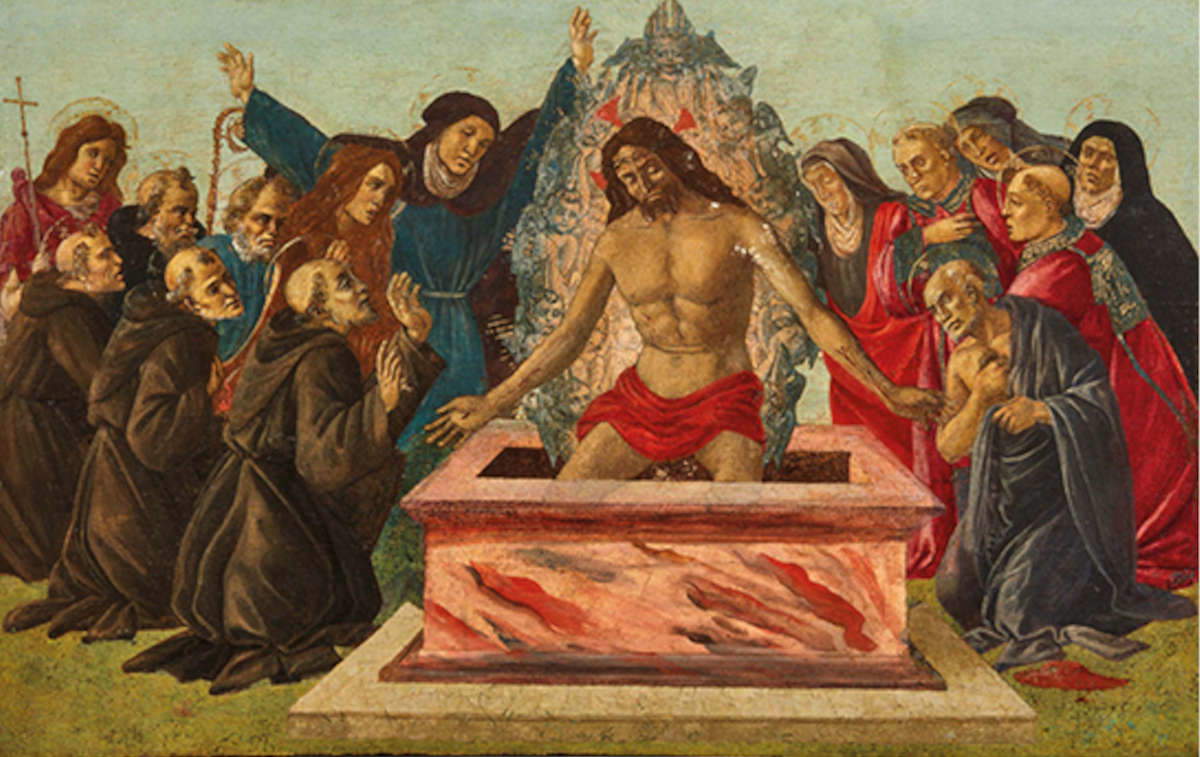A forgotten work from Sandro Botticelli ’s workshop returns to light after nearly a century and is set to be auctioned in Florence, Italy, by Pandolfini, on Oct. 29, 2025. It is the Deposition of Christ in the Sepulcher with the Virgin, Magdalene, Saints and Saints, tempera and oil on panel measuring 65 by 40.5 centimeters, which remained hidden in a private collection in Milan where it was kept without its real importance being known. For more than four decades the owners had retained only a fragmentary memory of the purchase, handed down from father to son, without realizing the work’s value. The first recent report came in the form of a photograph of modest quality, but enough to awaken the attention of scholars. Indeed, the image evoked the memory of a painting that had passed through the hands of Vittorio Cini, the great Venetian collector, but of which traces had been lost for nearly a century.
The lack of iconographic documentation had so far prevented it from being given a certain name. The work had thus remained relegated to the limbo of dispersed paintings, until direct viewing clarified its origin: the panel came from the workshop of Sandro Botticelli. A conclusion that coincides with the judgments already expressed in the past by two great art historians, Bernard Berenson and Federico Zeri, who had noticed it in the past and called it “Botticelli’s study” and “Botticelli’s workshop,” respectively.
The work can be dated to the 1590s, a period when Botticelli was deeply influenced by Girolamo Savonarola, the charismatic figure who had marked the religious and cultural life of Florence. The most convincing stylistic comparisons place the Deposition among turn-of-the-century achievements, juxtaposing it with the tondo preserved at the Gardner Museum in Boston, the predella of the Coronation Altarpiece at the Uffizi, and the Judith now in the Rijksmuseum in Amsterdam.

The material author of the painting remains unknown, but it is certainly one of the most interesting collaborators of Botticelli’s workshop, to be clearly distinguished from the inferior followers. The high quality of execution, the expressive intensity of the figures and the compositional refinement confirm that the panel is not the work of a mere imitator, but of an artist close to the master, capable of assimilating the distinctive features of his art and reinterpreting them with personal sensitivity.
According to scholars, the work was conceived for the private devotion of an educated patron, most likely linked to Franciscan circles. The choice of the theme, the Deposition of Christ in the Sepulcher, is part of an iconographic vein that in the late 15th century had experienced a great diffusion, especially in spiritual contexts influenced by Savonarola’s preaching, characterized by a strong call to meditation on the Passion.
The work’s return to prominence now comes through the Florentine auction dedicated to ancient paintings, an event eagerly awaited by enthusiasts and experts alike that will offer a fine selection of works from the 15th to 18th centuries. The Oct. 29 event in Florence is thus not only a market event, but also an opportunity for historical and critical insight. The public will be able to admire live a panel that had remained invisible for decades, while scholars will have the opportunity to analyze it more closely, enriching their knowledge of Botticelli’s production and the role of his most gifted collaborators. With its upcoming appearance at auction, the painting is preparing to enter a new phase in its existence.
 |
| Retrieved unpublished work from Botticelli's workshop that was noticed by Berenson and Zeri. It will go to auction |
Warning: the translation into English of the original Italian article was created using automatic tools. We undertake to review all articles, but we do not guarantee the total absence of inaccuracies in the translation due to the program. You can find the original by clicking on the ITA button. If you find any mistake,please contact us.